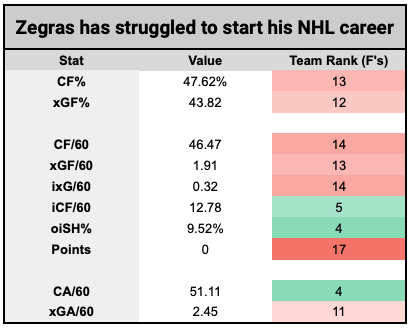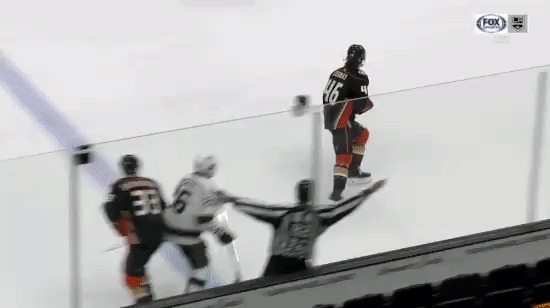How Trevor Zegras Can Develop From Top Prospect Into An NHL Star
By: Josh Simpson, Analytics Intern, Sarnia Sting (OHL)
This past holiday season, Anaheim Ducks prospect Trevor Zegras took the hockey world by storm, leading the World Junior Hockey Championship in scoring en route to a Gold Medal finish for the United States.
Zegras dominated the tournament in a way that few players can. The dynamic young forward showcased elite talent, with his puck skills, vision, deception, and much-improved wrist shot/one-timer putting him on the highlight reel seemingly every single night.
Post gold medal celebration, Zegras hopped on a plane headed south and proceeded to suit up in 8 AHL games for the San Diego Gulls, where he continued to light the lamp posting 4 goals and 9 points in his first taste of professional hockey. Fans screamed for him to be called up to the struggling NHL Anaheim Ducks, and eventually, they got what they wanted.
Zegras has arrived in Anaheim, but maybe not quite in the way that fans were hoping for - at least not yet.
Evaluating Zegras’ NHL play with statistics
No matter how you slice it, Zegras hasn’t exactly started his NHL career guns a-blazing. Through 9 games played, the rookie has just 2 points, and is still searching for his first NHL goal.
A deeper dive into the numbers paints an even worse picture of how the 19-year-old’s first 9 games have gone in the big leagues, and gives us a bit of a more detailed look at what he needs to work on.
Take a look at the chart here that is filled with some on-ice and individual statistics, accompanied by where he ranks among all 17 Ducks forwards who have played at least 50 minutes this season:
The Ducks are a bad team, and Zegras has been one of their worst forwards at driving shot attempt differential and expected goals differential, as you can see by the poor CF% and xGF% numbers. Dividing these numbers up into offensive numbers and defensive numbers tells us the following:
Zegras has been poor at generating offence across the board. The team generates few shots and expected goals when he is on the ice.
Zegras is not generating very many xG at an individual level, either, as you can see by his low ixG/60 total, but he is shooting the puck a lot with a relatively high iCF/60. Essentially, he is shooting the puck often enough, but almost exclusively from low-danger areas.
Despite having one of the best oiSH% on the team, Zegras hasn’t scored a point at 5v5. This essentially means that the Ducks are not getting unlucky with him on the ice, despite his low point totals.
Zegras is doing very well at limiting shots against when he is on the ice, and is around team average (slightly below it) at limiting expected goals against. He’s been *fine* defensively.
In summary, Zegras needs to find a way to generate more scoring chances at 5v5, because right now, he’s not creating nearly enough offence - especially for somebody who is considered to be a potential star offensive player. His defensive numbers are fine, but could get better.
How can he do all of that? Let’s check the tape:
Scouting Trevor Zegras
I watched a number of Trevor Zegras shifts with the intent of figuring out what was stopping such a talented young player from creating offence at even strength at the NHL level.
From what I saw, a number of encouraging parts of Zegras’ translated quite well. For example, he’s still able to manipulate defenders using deceptive moves in the offensive zone, and I saw a number of eye-catching rushes from him. This play is just ridiculous stuff:
Zegras also showcased an intelligent off-puck game in all three zones. He was able to play between checks in the offensive zone, he was consistently in a good defensive zone position, and he always made himself a passing option when his team had the puck on the breakout. I didn’t take issues with much of anything he did away from the puck.
Two things stood out to me about his game in a negative light:
1) Rush Patterns
I wasn’t very fond of what Zegras was doing upon crossing the opponent’s blue line. I found that a lot of the time, instead of patiently holding onto the puck and drifting into open space, Zegras would elect to fire a low-danger shot towards the net and hope for the best. Here are a few clips of what I’m talking about. The arrows in the video display space Zegras could have taken advantage of, but didn’t:
This aligns with the data I showed earlier in the piece, too - Zegras is taking shots at a high enough rate (high iCF/60), but despite that, he is not getting nearly enough high danger chances (low ixGF/60). This also contributes to why his team doesn’t generate many shots (CF/60) or scoring chances (xG/60) with him on the ice - his attacks are often one-and-done, rarely creating multiple shots/chances in one OZ possession.
I wonder how much of this is simply because Zegras is scared to make a bad play - after all, he is an NHL rookie who hasn’t become a staple in his team’s lineup, it would make sense that he would be scared to turn pucks over.
Regardless, if I were working with Anaheim’s development staff, I’d be showing him the clips I pasted above, and try to encourage him to hold onto the puck and attack space more often. He’s not going to get the most out of his skill set by firing unthreatening shots from a distance - he’s going to do it by moving around the offensive zone, manipulating defenders and creating passing lanes that he can exploit with his terrific passing ability.
2) Strength
The other thing I noticed was that Zegras was consistently getting muscled off pucks, and in multiple different ways. Whether it was an opposing player lifting his stick, rubbing him out into the boards, or simply knocking him down, he’s not very good at holding on to pucks under pressure at this level, which obviously limits his effectiveness against men. Here are some examples of him being outmuscled against NHL opponents:
He’s going to need to be able to embrace and shake off contact in the future to get the most out of his lethal playmaking ability. This will help him extend more plays while under pressure, allowing him to generate more offence and maintain possession more often in the offensive zone.
This is a pretty simple fix. I don’t really take any issue with Zegras’ puck-protection mechanics, so the answer to this problem is clearly added strength. Zegras isn’t exactly undersized, standing at 6’0 tall, but he’s going to have to fill out his frame with more muscle to become more of a threat with a defender on his back at the NHL level.
Fortunately, all he needs to do to address this issue is hit the weight room, get his protein in, and repeat, but unfortunately, he’s not going to wake up and be able to bench press 4 plates by tomorrow. This part will take some time.
Conclusion
All in all, Zegras is a dynamic young talent with a tonne of potential, but he’s struggled to start his NHL career and he needs to work on two fixable aspects of his game to take it to the next level. I suspect he’ll be able to do so and develop into a huge part of the Anaheim Ducks’ future.






